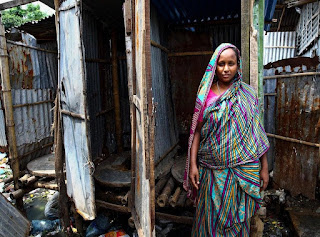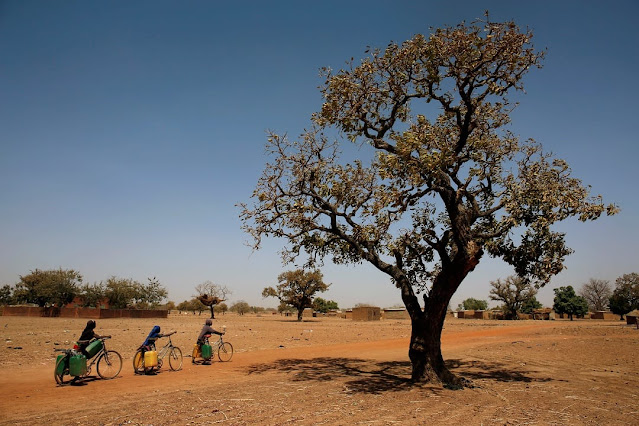WaSH and gender-based violence
Understated violence behind water collection and toilet facilities
Patriarchy comes in all forms. Patriarchal violence is undoubtedly the most gruesome form of sexism, one that is routine everywhere in the world. Women and girls collecting water and practising open defecation in Africa are not safe: they are commonly greeted with male violence at water point queues, water fetching paths and open defecation routes. Women are also subjected to domestic abuse when they fail to gather enough water to complete their domestic responsibilities. Thus it is important to adopt an "engendered" interpretation of the right to sanitation.
Why do women practice open defecation?
Open defecation is a product of patriarchy: the lack of consideration of differential gendered sanitation needs and the dominance of men in decision making in both the domestic and public sphere means toilet facilities are not designed to meet the basic sanitation needs of women. The topic of open defecation is complex: debates surrounding gender inequalities, sanitation, resource distribution, cultural politics, everyday habits, political will and capacity etc., all come into play in the politics of shit. In addition, locational specificities are also a factor: cities, rural villages, informal settlements etc. The number of people using the toilets makes the conditions of the toilets almost impossible to manage. Many toilets have missing doors, locks, are flooded or blocked and are unclean. In recent years, governments and NGOs have been working to increase toilet provision.
Case study: Mathare
Mathare is an informal settlement in Nairobi. Mathare is underserved in the formal provision of water services. Nairobi City Water and Sewerage Company is the city's formal water service provider and they were not shy to admit that they lacked efforts to extend their water services to informal settlements. The number of people who rely on a single toilet facility ranges from 17 to 232. As a result, many residents rely on informal water vendors. However, Sanergy provided more than 140 toilets in Mathare, most of which charge a fee. There is also an option to pay a monthly family fee, which is anywhere between KES 100 to KES 150. Due to the time and energy women spend collecting water, they have little to no capital to afford these fees. Furthermore, their economic dependence on their spouse is also a contributing factor to their lack of voice in decision-making at home, thus do not have the authority to allocate money towards their sanitation needs. Additionally, the unkempt conditions of the toilets, especially the lack of good lighting in toilets and the paths leading to the toilet, creates a sense of insecurity and lack of safety, which means that most women are confined to open defecation. A third of the women in Mathare, based on a study of 55 women in Mathare, rely on buckets, plastic bags or open defecation during the day, and two-thirds of the women from this study rely on these practices at night.
Explaining violence
The clear-cut domestic gender norms make men the breadwinner and main economic providers of their household, whilst women are responsible for collecting water and doing other domestic chores, including cooking, cleaning (which requires water) and nurturing their children. However, the lack of consistent and reliable access to water amplifies a woman's likelihood of being a victim of domestic abuse, especially in regions such as sub-Saharan Africa, which is prone to drought. When men work almost tirelessly and come home to no water or a cooked meal, it triggers them. Men associate their wife's inability to fulfil their spousal duties and expectations to the dowry they paid, and therefore feel that acts of violence against their wife are justified.
Women collecting water or finding a space to defecate are extremely vulnerable to male-attack. Women and girls are often alone, walking long distances - predominantly in the early hours of the morning or the late hours of the evening when it is dark - to collect water. Men see this as an opportunity and seize that opportunity to rape women. Some of the most prevalent factors that contribute to the frequency of women being victims of rape and sexual assault are the predictability and the poor lighting on the routes that they take. Each village or community only have access to a number of water collection points, thus the routes are easy to memorise, for both the women collecting water and the men who prey on these women. Men wait for women on these routes, which are largely isolated. It is easy to study the water-fetching schedules of most women. Younger girls are particularly vulnerable and raped at a higher rate: their perceived sexual innocence and physical weakness mean that they are an easier and more ideal target.
Conclusion/ solutions
While the proportion of people practising open defecation has reduced by 11% between 1990-2010, the absolute number of people practising open defecation has increased by 33 million during the same time frame as a result of rapid population growth. 8% of urban sub-Saharan Africa and 35% of rural sub-Saharan Africa continue to practice open defecation today. There have been efforts to eliminate open defecation. For example, MDG Target 7C and SDG 6 was and is to achieve safe water and sanitation. Access to improved sanitation is defined by the JMPas as sanitation facilities that hygienically separate human excreta from human contact, thus reducing open defecation rates and meeting sanitation goals go hand-in-hand.
The UN's Sanitation Drive advocacy campaign is working to eliminate open defecation practices by empowering communities as a whole to become open-defecation free, raising awareness of the risks associated with open defecation and generating a collective sense of intolerance towards open defecation. However, there are severe implications of stigmatising behaviours and techniques of improvisation that most women rely on for their safety. It is important to acknowledge the risks of the solutions to WaSH, such as the Sanitation Drive campaign. We should start by making toilets free, well-lit and segregated. It is also important to consider the risks of segregated toilets. The risks of providing gender-based segregated toilets affect the LGBTQ+ community, especially the transexual community, who may feel stigmatised regardless of which toilets they choose to use, thus it is also important to provide gender-neutral toilets to ensure the safety of all women, not only cis women.


Good presentation with good engagement with literature, and references are well embeded. How does sanitaion and violence in relation to access to water and gender inequality fit within the broad schole of SDG 16?
ReplyDeleteThanks Clement! I think the issue surrounding women's safety in the politics of water and sanitation is central to promoting "peaceful and inclusive" societies to ensure justice for women. SDG 16 not only relates to the theme of peace, inclusion and justice but also accountability from all institutions. WaSH management and access is a structural issue, in which the nation states need to be held accountable for (as well as their coloniser nations). However, gender-based violence and rape is a cultural issue, which is harder to govern, manage and hold one institution accountable for. I hope this answers your question!
DeleteHi Arzoo, I really enjoyed reading your post! In particular, I think the example of Sanergy's interventions in in Mathare call to attention the need to situate sanitation solutions within the social and cultural contexts of the community, as merely providing the infrastructure does not fully solve the problem. In regards to the violence and vulnerability women are plagued with when attempting to access WASH sites, I'm wondering if there are embodied forms of micro-resistance that women also employ, such as perhaps banding together in groups to travel to WASH sites? :)
ReplyDeleteHi Joanne, thank you for your comment! Women definitely engage in forms of micro-resistance, such as visiting toilets and water collection points in groups. Another technique of micro-resistance is travelling in the late hours of the night or early hours of the day. While this may seem counteractive because as I mentioned, bad lighting in these paths are a cause of anxiety, going during these hours reduces their chances of being seen (and therefore approached and harassed) by men.
DeleteHi Arzoo! Great post - I really liked how you considered trans women in your argument - it is often forgotten in common literature. I wanted to know if you knew of any bottom up/grass roots efforts to alleviate this issue?
ReplyDeleteHi Chloe! I have tried to research this but I have not found any projects that specifically aims to help trans-women with toilet politics. I think one of the reasons for this is possibly the fact that this is considered a very "progressive" issue that isn't currently on any national agendas in the African continent as they still have a long way to go to achieve their minimum sanitation goals.
DeleteHi Arzoo! Thank you for sharing these pertinent issues on your blog. I found your concluding sentence, acknowledging the LGBTQ+ community, particularly interesting. Do you know of a case study where toilets have been successfully installed in line with such inclusive sensibilities?
ReplyDeleteHi Steph! Unfortunately I have not found any case studies whereby inclusion of trans-women in toilets have been considered. I think this is definitely something that more WaSH projects need to consider in the future to ensure their safety.
DeleteHi Arzoo! Love the use of subheadings here - made the post so such easier to follow, especially in terms of the conclusion. The use of case studies clearly layouts out the examples and backs up all your points
ReplyDelete